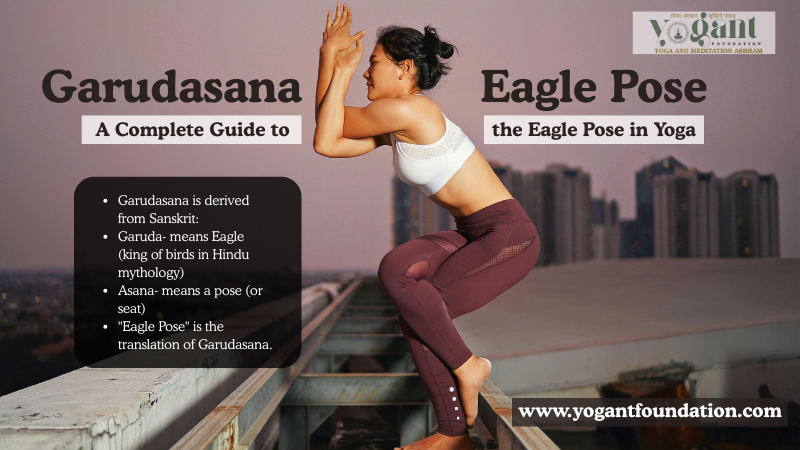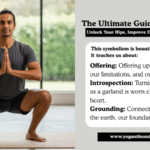Garudasana also called Eagle Pose. This posture has one of strongest balances. Garuda is the name of Lord Vishnu’s mythical vehicle, the mythical Garuda. It represents focus, strength, and expansion. Garudasana, like Garuda, helps you to rise above distractions and bring harmony to both your mind, body, and soul.
This detailed guide will explore Garudasana’s meaning and benefits as well as its common errors and symbolism. It also explores the connection between Garudasana and Hatha Yoga and Pranayama.
Spread our wings and jump in!
Meaning and Origin of Garudasana
Garudasana is derived from Sanskrit:
- Garuda- means Eagle (king of birds in Hindu mythology)
- Asana- means a pose (or seat)
“Eagle Pose” is the translation of Garudasana.
Garuda is a symbol of power, speed, and the ability to transcend duality in ancient texts. This asana, when performed properly, channels these qualities. It awakens awareness and balance in both the physical and mental realms.
Garuda, in mythology, is associated with his devotion to Vishnu as well as his fierce defense against evil. In the same way, this pose encourages focus, devotion and inner strength.
What is Garudasana (Eagle Pose)?
Garudasana, or standing balance pose, is achieved by twisting your arms and legs in a way that resembles the shape of a coiled eagle about to fly. This is an important posture for Hatha Yoga. It’s also used in Ashtanga Yoga and Vinyasa flow to improve balance, flexibility, and concentration.
This pose calms and strengthens your mind while strengthening the hips, legs, shoulders, and core. This pose requires focus and coordination. It is an ideal practice to ground energy and align the mind-body relationship.
The Symbolism of the Eagle in Yoga
In many cultures, the eagle represents clarity, freedom, and higher vision. Garuda is the Hindu symbol for prana, which represents energy.
Practicing Garudasana reminds us to:
- Stay Focused in the Chaos
- Stillness and motion in one embrace
- Find the balance between hardness and softness
When your inner world is stable, you will be able to move with grace.
How to Do Garudasana Steps Guide
Garudasana poses are challenging and require both mindfulness and patience. Garudasana: How to practice it safely.
1 Step: Starting Position
Standing in Tadasana, (Mountain Pose), your feet should be together with your arms down by your sides. You can center yourself by taking a few deep breathes.
2 Step: Bend Your Knees
As if you were sitting in a chair, shift your weight to your right leg and slightly bend your knees. Maintain a straight spine and look forward.
3 Step: Wrap the right leg
Cross your left leg over the right leg. Hook your right foot behind your left calf if possible. Here, balance is key. Engage your core.
4 Step: Wrap your arms
Both arms should be extended forward. At the elbows of both arms, cross them over. Wrap your forearms in such a way that the palms are facing each other.
5 Step: Align and Balance
Lift your elbows up to your shoulder height. Fix your gaze on a point that is stable (drishti) to maintain balance.
6 Step: Maintain the pose
This posture and deep breathing for between 5 and 8 breaths. The twisting and movement of your joints as well as your hips will make you feel it.
7 Step: Release & Switch
Return to Tadasana by slowly unwinding your arms and legs. Repeat on the other side.
Key Alignment Tips
- Maintain your legs centered.
- Engage your core muscles for balance.
- Your shoulders should be relaxed away from your ears.
- Maintain your focus on a single point.
- Do not force yourself to wrap your legs or arms — with time, the flexibility will increase.
Variations of Eagle Pose
Garudasana is a great example of how yoga offers flexibility. It has many variations, both for beginner and more advanced practitioners.
1. Half Garudasana (Beginner)
Crossing one leg without hooking it over is an alternative if full wrapping seems difficult. Press the palms together and cross your arms.
2. Seated Garudasana
Eagle Pose is performed while sitting in a chair. This option works well for people with knee or balance problems.
3. Reclined Garudasana (Supine)
Cross your legs while lying backwards, and then wrap your arms around your waist in Garuda style. This is a great way to release tension from your hips and shoulders.
4. Eagle Pose Arms Only
Stretch the upper back and shoulders by using the arm wrap in standing or sitting postures.
5. Advanced Garudasana with Forward Bend
Fold forward at the hips, while holding the wrap. This will intensify the stretch and challenge focus.

Top 8 Physical Garudasana Benefits
Eagle Pose has a variety of benefits, both physical and psychological. Garudasana has many benefits, as proven by science and anatomy.
1. Strengthens Legs and Ankles
It is important to balance this posture in order to strengthen the legs and build up endurance.
2. Opens the Shoulders and Upper Back
This arm twist will stretch your shoulders, traps, and deltoids, relieving you of stiffness caused by poor posture and desk work.
3. Increases joint mobility and circulation
Garudasana increases blood flow in the joints by compressing them.
4. Improves Circulation and Joint Mobility
The balance challenge on one foot will help you improve coordination, awareness and proprioception.
5. Improves Concentration and Focus
As you maintain your balance, your mind will become calmer and focused.
6. The Core Strengthens
You can build a core that is strong and supportive by strengthening your abdominal muscles.
7. Increased Flexibility
Twisting increases the flexibility of the hips and knees. It also improves shoulder, wrist, and arm strength.
8. Relieves Sciatica and Back Pain
Eagle Pose, when performed correctly, releases tension from the lower back and helps relieve mild sciatic pain.
Mental and Emotional Benefits
Eagle Pose has a profound mental, as well as energetic, value.
- Mental clarity and mindfulness are promoted.
- Reduces restlessness and anxiety
- Develops inner equilibrium and self-control
- Encourages separation from distracting
- Enhances mind-body harmony
Garudasana is a moving mediation- it’s a powerful reminder to be aware, and not just try.
Eagle Pose in Hatha and Ashtanga Yoga
Garudasana, in Hatha Yoga, is considered to be a balance asana that harmonizes the flow of prana between the left (ida nadis) and right nadis (pingala ) while promoting energy balance.
It is part of the standing postures that are used to develop endurance, strength, and mindfulness prior to transitioning into seated positions.
Garudasana complements Pranayama practice — performed before breathing exercises, it stabilises the nervous system and prepares the body to focus more deeply.
Energetic and Chakra Connection
Garudasana activates chakras :
- Muladhara (Root Chakra): Increases stability and grounding.
- Ajna (Third Eye Chakra): Enhances intuition and focus.
- Anhata (Heart Chakra). Releases emotional blockages through shoulder expansion.
The pose harmonizes Pranic Energy flow by balancing the subtle and physical body. This is the first step in Meditation and Kundalini awakening.
Precautions and Contraindications
Garudasana is a powerful pose that can bring you many benefits. However, Garudasana must be done with mindfulness. If you feel:
- Injury to the ankle or knee
- Pain in the wrist or shoulder
- Vertigo or severe balance problems
- Only under the supervision of an expert can pregnancy women practice this procedure
For safety, if you’re new to yoga practice, sit next to a chair or wall.
Common Mistakes to Avoid
Even experienced practitioners can make subtle alignment errors in Garudasana. What to look out for
- Too much forward lean– Maintain your spine straight and center.
- Lowering the elbows– lift them to shoulder height
- Avoid over-twisting joints – The wrap should be firm but comfortable.
- Losing your balance– Focus on your core by focusing your gaze.
- Tense the shoulders- Keep them wide and relaxed.
Yoga is not about perfection, but rather union.
Garudasana Breathing Techniques
Garudasana benefits are enhanced by proper breathing:
- Inhale while you extend and prepare your spine.
- As you wrap and twist the limbs, Exhale.
- Keep your breath rhythmic and steady throughout.
Take a few breaths deep in Tadasana after releasing to experience renewed energy.
Integrating Garudasana into Your Practice
Garudasana is a great addition to your yoga practice.
- Warm-up: Start with gentle hip and shoulders stretches, such as Cat Cow, Gomukhasana or arms.
- Peak pose: Garudasana is performed after foundational poses like Tree Pose or Warrior II.
- Relaxation : Perform seated twists or bends to the front.
Eagle Pose & Meditation
Eagle Pose can be a powerful meditation in motion when it is performed mindfully and with focus. Concentrating on your balance will quieten the chatter in your head and help you to focus.
Combining it with Pranayamas, like Nadi Shudhana or Anulom Viom will increase your concentration and calmness. Garudasana goes beyond a simple posture. This is a method to calm the mind.
Eagle Pose Spiritual Insights
Garudasana is a yoga pose that teaches elevation and detachment. As the eagle watches the world below, so too do yogis.
It invites you to spread your inner wing to overcome fear, doubt, and limitations. This posture represents liberation from the ego and connection to your higher self.
Sequence Example Including Garudasana
Try this short flow of yoga:
- Tadasana (Mountain Pose)
- Utkatasana (Chair Pose)
- Garudasana (Eagle Pose)
- Virabhadrasana II (Warrior II)
- Trikonasana (Triangle Pose)
- Adho Mukha Svanasana (Downward Dog)
- Balasana (Child’s Pose)
The flow is designed to balance flexibility, strength, and mindfulness while harmonizing the body and breath.
Garudasana for Beginners: Modifications and Props
Here are some suggestions to help you if you find it difficult to balance:
- Support yourself with a chair or wall.
- Try to feel the stability of your arms and legs by practicing separately.
- If flexibility is not possible, cross your leg lightly.
- Instead of perfection, focus on continuous breathing.
With regular practice, your flexibility and balance will improve.
Advanced Practice Tips
You can then deepen your practice once you are comfortable with the basic version:
- For a variation that is hip-intensive, try Garudasana combined with a forward folding.
- Focus on breathing and eye stability.
- Try out other Eagle Arms poses, such as Gomukhasana (Warrior III), or seated meditation.
To improve concentration and drishti, advanced yogis combine Garudasana (gazing meditation), with Trataka.
Garudasana in Modern Yoga and Wellness
Eagle Pose has been practiced worldwide for centuries, from Hatha Yoga Schools in Rishikesh up to the most modern of studios. The intention of this flow is to combine flexibility, strength and mindful awareness. While harmonizing body and breath.
This pose helps improve balance and is often used for sequences which focus on the body’s equilibrium as well as rehabilitation exercises.
Garudasana has been emphasized as an example of Awareness, Balance, and Transformation. In both yoga and wellness programmes, aligning with holistic yoga philosophy.
Daily Life Lessons from Garudasana
Garudasana is more than just balance.
- When life twists and turns, stay centered.
- When distracted, return to your breath.
- Challenged, remember — stillness gives you power.
If the eagle is using the wind to get higher in the air, it does not resist. Garudasana with mindfullness is the symbol for rising gracefully above the turmoil of life.
Key Takeaways
| Aspect | Details |
|---|---|
| Sanskrit Name | Garudasana |
| English Name | Eagle Pose |
| Type | Standing Balance Pose |
| Focus Areas | Legs, shoulders, hips, and core |
| Primary Benefits | Balance, flexibility, focus, circulation |
| Chakras Activated | Root, Heart, and Third Eye |
| Difficulty Level | Intermediate |
Final Thoughts: Fly High with Garudasana
Garudasana teaches us that the true power lies in graceful, controlled, and not force. You can unlock inner peace and physical strength. By twisting, breathing, balancing, and completing challenges.
Imagine your wings spreading each time that you do yoga. They are grounded like the earth and yet they fly free. Garudasana helps you to achieve balance and calmness.
Related Yoga Poses You Can Explore
- Vrikshasana (Tree Pose) – for balance and grounding
- Gomukhasana (Cow Face Pose) – for shoulder flexibility
- Trikonasana (Triangle Pose) – for body alignment
- Tadasana (Mountain Pose) – for posture and awareness
- Utkatasana (Chair Pose) – for strength and focus



